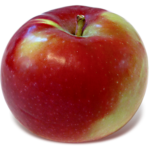

- The McIntosh apple was discovered by John McIntosh on his farm in Dundela, Ontario, Canada, in 1801. It was a chance seedling, but Fameuse (also know as Snow apple for its white flesh) and the heirloom Detroit Red are generally credited as its parents.
- It took nearly 70 years before McIntosh’s commercial release. The first McIntosh planted in the United States was in Newport, Vermont, in 1868, in one of Dr. Thomas H. Hoskins’ orchards.
- McIntosh were steadily gaining in popularity in New England through the early part of the 20th century, and eventually they supplanted Baldwin as the region’s leading apple after the severe winter of 1933-34, which killed more than one million Baldwin trees.
- Today McIntosh accounts for nearly two-thirds of the New England apple crop.
- McIntosh is considered among the most aromatic of apples.
- McIntosh is prized for its strong, distinctive flavor, more tart than sweet when first picked, gradually mellowing in storage.
- McIntosh is known for its juiciness for fresh eating. Its juice content can cause it to break down during cooking, making it an excellent choice for applesauce and in pies, often mixed with firmer varieties. It is an outstanding cider apple.
- Thanks to improved storage techniques, the days of the “soft Mac” are over. Some of the best New England McIntosh of the 2015 harvest were available in late May, still crisp and flavorful. Like all apples, McIntosh should be kept very cold, 34°F, to maintain freshness.
- McIntosh is a mid-season apple, ready for picking at many New England orchards on or around Labor Day and continuing to be harvested throughout most of September.
- McIntosh is a parent of some of New England’s most well-known varieties, including Cortland, Empire, and Macoun, and many strains like Marshall McIntosh and RubyMac.
APPLES ARE the most gregarious of foods. They get along with everybody.
Morning or night — it does not matter when you serve them. Sweet or savory — it does not matter who you invite along.
One combination that is not obvious, surprisingly, is apples and bananas. Their strong flavors and contrasting textures can work well together. But when I think of mixing apples with other fruits, pears or raspberries first come to mind, or dried fruits like raisins or cranberries.

Whenever I am looking for a good apple recipe, I go to the Apple Cookbook by Olwen Woodier. This 1984 volume is as solid and straightforward as its name. Her recipe for Apple Banana Bread has just eight ingredients and can be assembled quickly. The results are outstanding, as neither fruit overpowers the other. It is not too sweet, especially if you use an apple like McIntosh that has some tartness. The lack of spices allows the apple and banana flavors to blend without distraction. I keep the peels on, since they add color and contain much of the apple’s nutrition.
I often add nuts to banana bread but, like spices, they detract from the apple and banana.
The resulting bread is good at any hour, for breakfast, a snack, or dessert, served plain or with a little peanut butter, cream cheese, or butter.
This recipe is based on Olwen Woodier’s version.
Apple Banana Bread
1 c flour
¾ c whole-wheat flour
2 t baking powder
½ t baking soda
2-3 ripe bananas
½ c brown sugar
½ c butter, melted
2 eggs
1 large McIntosh or other sweet-tart New England apple, cored and diced
Preheat oven to 350ºF. Grease an 8″x4″ or 9″x5″ loaf pan.
In a large mixing bowl, combine flour, baking powder, and baking soda. Make a well in the center.
Mash bananas in a separate bowl, and beat in sugar, butter, and eggs. Pour into the center of the dry ingredients and stir until just combined.
Fold apple into the batter, and pour into the pan.
Bake for one hour, or until a toothpick inserted in the middle comes clean. Cool in the pan for 10 minutes, and then turn out of the pan onto a wire rack. Cool completely before cutting.



